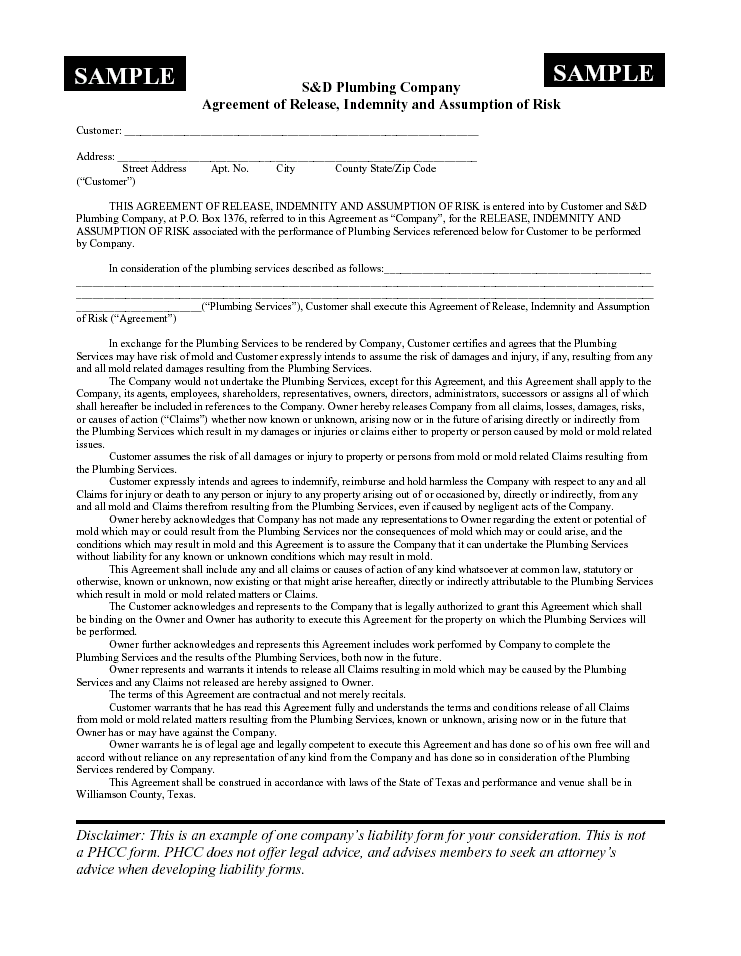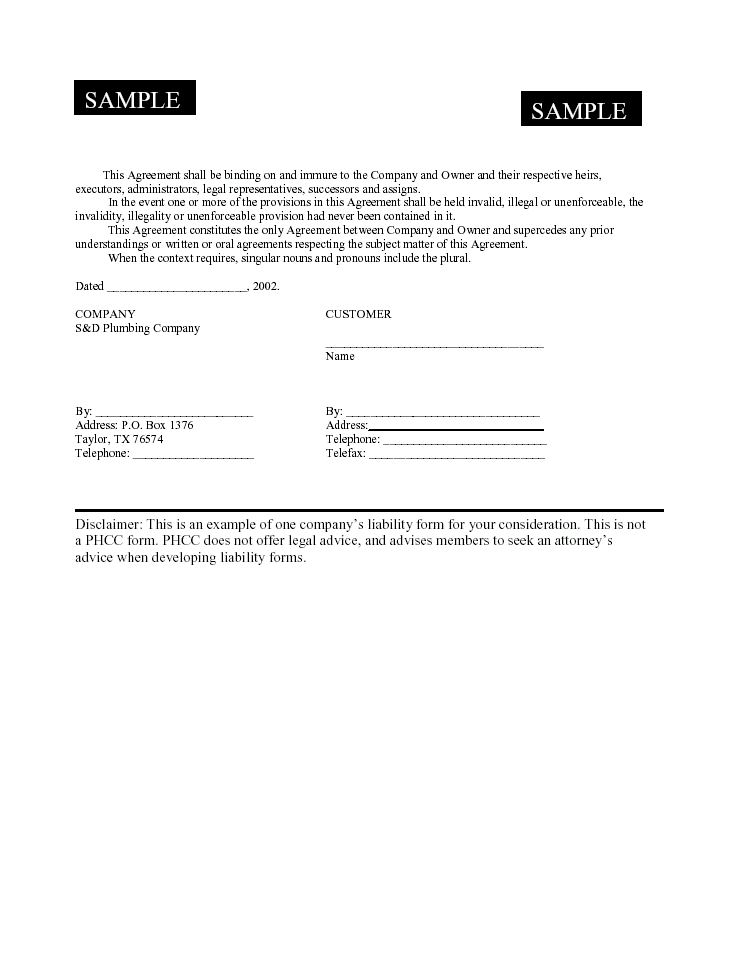That’s why the latest black mold hysteria has prompted Dowdy to come up with his own method of protecting his company in the event of a black mold lawsuit. It’s an “Agreement of Release, Indemnity and Assumption of Risk” form associated with the performance of plumbing services — those with black mold ramifications.
The second paragraph of the agreement states, “In exchange for the Plumbing Services to be rendered by Company, Customer certifies and agrees that the Plumbing Services may have risk of mold and Customer expressly intends to assume the risk of damages and injury, if any, resulting from any and all mold-related damages resulting from the Plumbing Services.”
Dowdy said the inspiration for his agreement stemmed from a meeting of Plumbing-Heating-Cooling Contractors (PHCC) last year. He is a member of the Texas PHCC Task Force on Mold Issues. “I sat in on a PHCC meeting and there were at least four plumbers there who had multimillion dollar mold lawsuits against them,” he said.
Dowdy said the large number of high-profile, multimillion dollar judgments involving customers suing insurance companies over mold claims has changed the entire landscape of the insurance business.
“Insurance companies are getting tired of the lawsuits, and they are looking to shift the responsibility to someone else,” he said.
“An insurance company filed a claim against us on behalf of a homeowner whose ice maker line to the refrigerator had burst and flooded the room,” he said. “We had nothing to do with the line. We only work with the water going into the line.”
CHANGES IN COVERAGE
“The recent publicity over the past two years has been brought about by high-profile cases in Texas,” said Jerry Johns, president of the Southwestern Insurance Information Service, Austin, TX.“The amount of losses that insurers have sustained in water-related mold claims and the large dollar amount of these claims has brought the problem into the open.”
The large claims have prompted the Texas Department of Insurance (TDI) to redefine mold claim damages, while still offering increased coverage for mold-related problems. The reworked homeowner policy was outlined by insurance commissioner Jose Montemayor recently.
“The new homeowner policy will provide for basic repairs,” Montemayor said. “It eliminates high-priced procedures which are driving up costs, such as testing, treating, containing, or disposing of mold beyond that necessary to repair or replace property that is physically damaged by water.”
“The eyes of the nation’s insurance regulators have been on Texas in recent months and are likely to remain there as we deal with what has come to be referred to in the news media as ‘the mold crisis,’” said Jim Davis, Director of Public Information at TDI. “Other states are beginning to have problems of their own on this subject, and their officials are watching what we do.
“The commissioner’s decision of November 28, 2001, regarding mold coverage is a common-sense, middle ground approach that gives Texas homeowners basic protection, plus the ability to purchase additional coverage if they so choose. This decision protects consumer choice and insurance availability, and addresses insurance cost drivers to help keep policies affordable.”
Davis added that insurance rates have gone up but under the circumstances, he doesn’t equate all increases to the new rash of mold claims. “We have seen rates increase, in some cases significantly, but it is difficult to tie the increases to any one particular reason. The huge increase in mold-related claims over the past couple of years has had an impact on rates paid by homeowners, but weather and other factors also played a part.”
Dowdy said that insurance companies need to look at the causes of black mold growth and make sure the responsible parties are educated as to its origins. “Homeowners are keeping their rooms cold and dark,” he said. “They need to bring in fresh air.
“It is not the fault of air conditioning contractors if homeowners act irresponsibly.”
EDUCATING THE HOMEOWNER
“Insurers will work with any responsible group to promote awareness of water-related mold damage,” said Johns. “Most recently we have been meeting with homebuilders, apartment owners, and lenders to ensure this process continues.“The insurance industry and their trade associations have gone to great lengths to educate consumers about the importance of cleaning up water which has escaped as quickly a possible. We have done this through web-based technology and printed material.
“We encourage customers to call in their claim immediately in order that a trained claim person can respond immediately.”
In the meantime, Dowdy said he will continue to promote his agreement between plumbers and customers. He cited an example of the problems he faces every time he investigates mold damage.
“Insurance companies are saying that the plumber is responsible for the activation of mold spores if he cuts into sheetrock to inspect for damage,” he said. “The products in buildings — such as construction material — create mold, not the water.”
“We didn’t create the hysteria. We simply report what we find and pass it on to the insurance companies.”
See below a copy of S&D Plumbing Co.’s “Agreement of Release, Indemnity and Assumption of Risk” form. PHCC points out that this is an example of one company’s form. This is not a PHCC form. PHCC advises its members to seek an attorney’s advice when developing liability forms.
Texas PHCC has developed “mold detection guidelines.” To obtain a copy of the list, call 800-533-7694.
For more information on black mold from the Southwestern Insurance Information Service, visit www.siisinfo.org/media/molds.htm (website).
Publication date: 04/08/2002



Report Abusive Comment